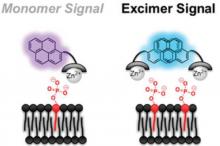BACKGROUND
Detection of negatively charged phospholipids can serve as indicators of apoptosis, bacterial presence, or diseases such as phospholipidosis. For example, phosphoserine, a negatively charged lipid, is largely present in the outer membrane of mammalian cells only in the event of apoptosis, while the negative net charge of bacterial membranes can serve to differentiate these cells from mammalian ones. Consequently, the phosphoserine binding protein, AnnexinV, has been used for detection of apoptosis, while the small molecule Zn2+-containing fluorophore, PSVueTM380, has been used for generic detection of negatively charged phospholipids and their indicative states. However, AnnexinV has several limitations (high Ca2+ levels required for binding, biochemical instability, slow rate of binding, need for washes) and the turn-on sensor PSVueTM380 has a short dynamic range.
TECHNOLOGY
Researchers at the University of Toronto have developed a set of turn-on, excimer-based fluorescent sensors (ProxyPhos) that can be selectively detected upon coordination with anionic membrane lipids. Each sensor is comprised of a Zn2+-coordinating chelate linked to a pyrene reporter. The positive Zn2+ ion binds to the negatively charged phospholipids whereafter interaction of two nearby pyrene motifs, driven by a hydrophobic preference for each other, generates the pyrene-pyrene species that can be detected through excimer fluorescence at ~ 480 nm (Figure 1).
Figure 1. Detection of negatively charged phospholipids (red) using ProxyPhos sensors. Co-ordination of the Zn2+ ion to the negatively charged phospholipids, facilitates inter-sensor associations between hydrophobic pyrene motifs. The resultant pyrene-pyrene species results in excimer fluorescence that is key to detecting negatively charged phospholipids, to the exclusion of single ProxyPhos sensor species (i.e. no washes required).
COMPETITIVE ADVANTAGE
- Significantly improved linear response (~ 4x) compared to PSVueTM380
- Enables quantification of negatively charged lipids over a large concentration range
- More effective for the detection of early apoptosis cells (3x) than PSVueTM380
APPLICATIONS
- Detection of:
- Bacterial cells
- Apoptotic events
- Mitochondria
- Phospholipidosis
INTELLECTUAL PROPERTY
- National Phase: US, CA
PROJECT STATUS
ProxyPhos sensors (Figure 2) have been synthesized and tested for detection of anionic lipids present in small unilamellar vesicles of various lipid compositions (i.e. POPC, POPE, DOPS, POPG, POPA or TOCL) and for apoptosis in mammalian cells. Results (detection limits, linear ranges) were benchmarked to the commercially available sensor PSVueTM380. ProxyPhos sensors demonstrated a 4x dynamic range and a 3x greater ability to detect early apototic cells when compared to PSVueTM380.
Figure 2. Structures of the six ProxyPhos sensors tested.





